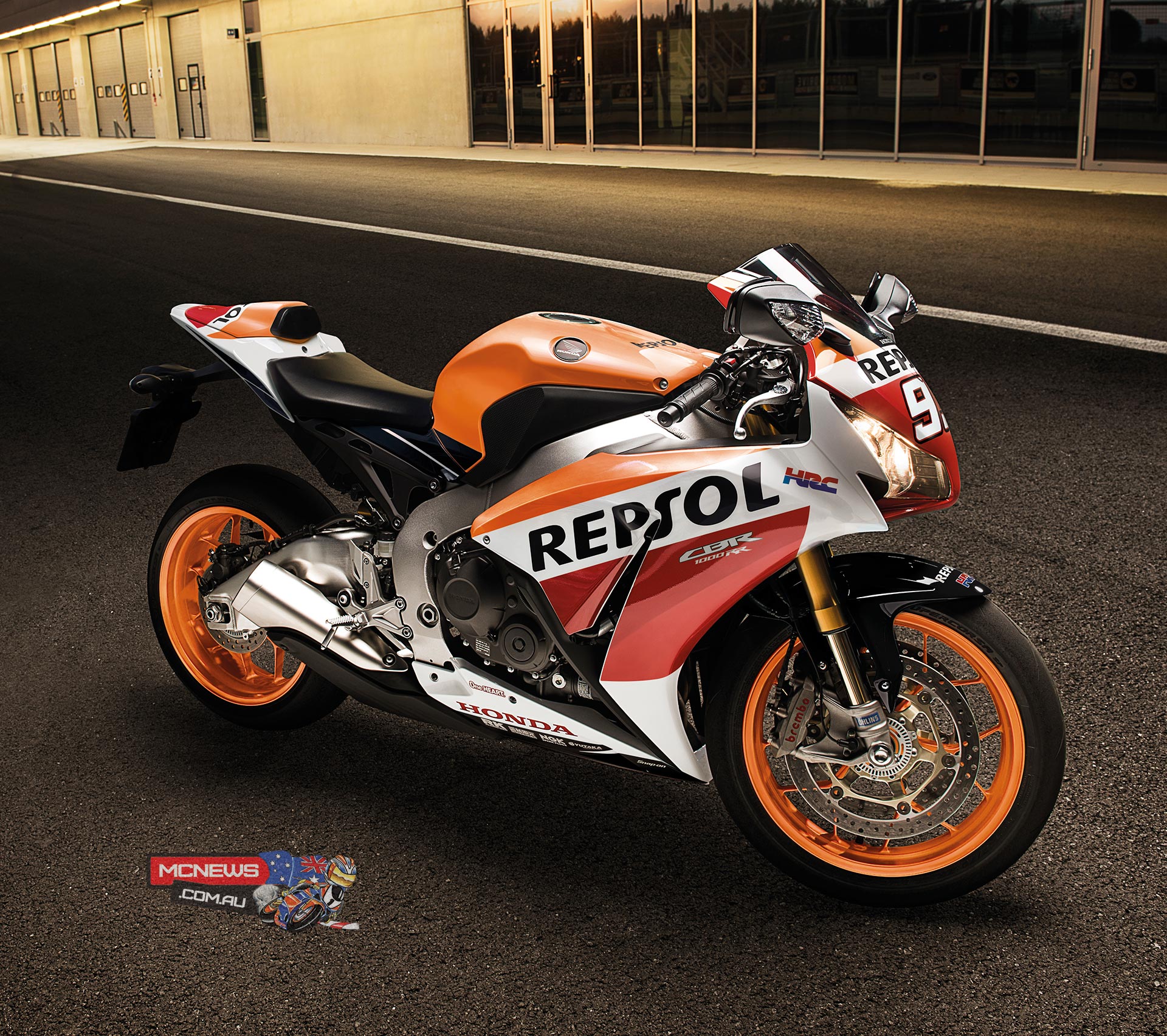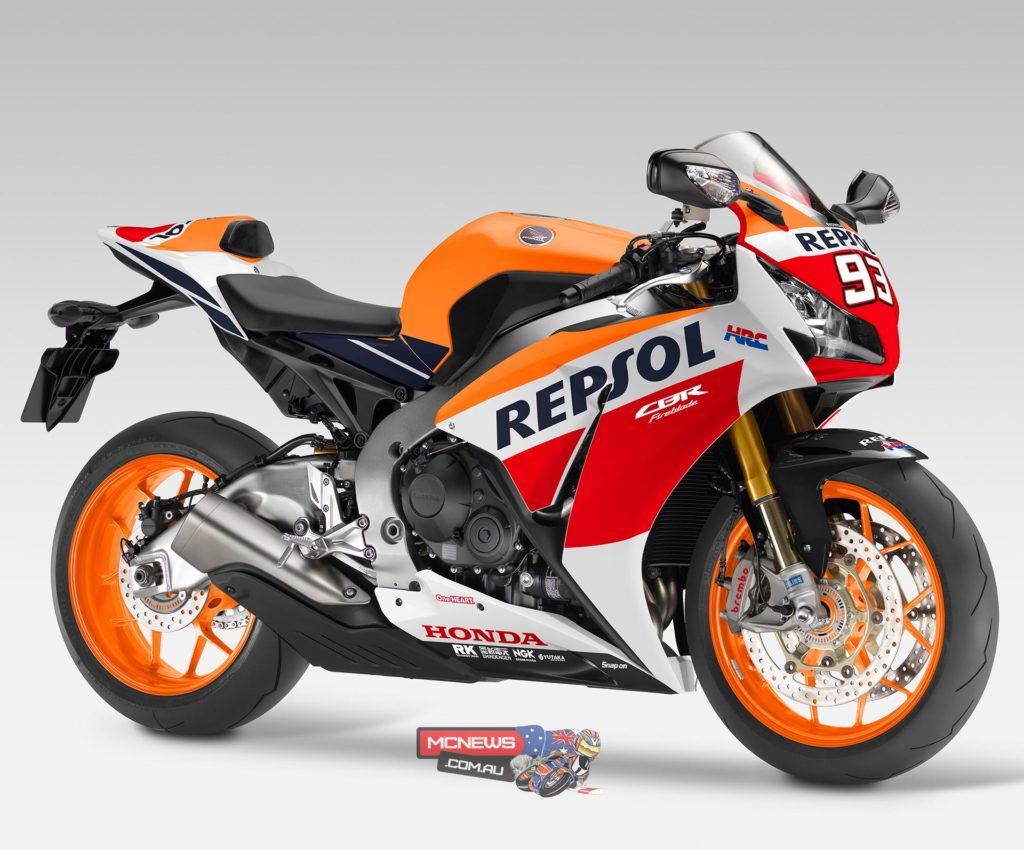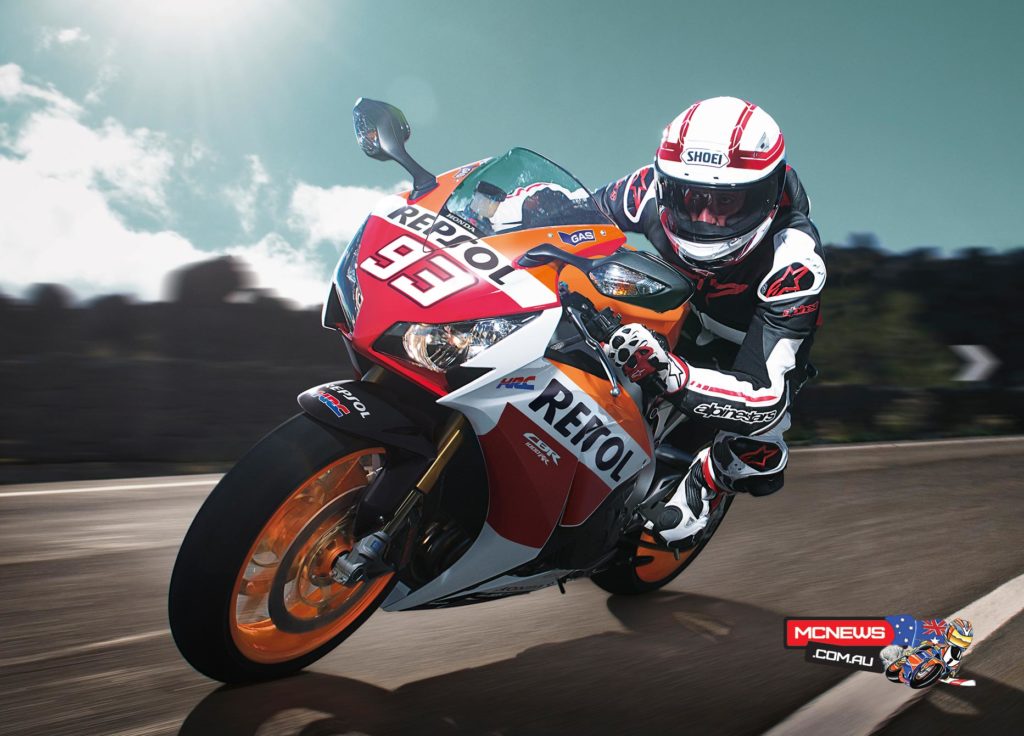Marc Marquez Repsol Replica 2015 Honda CBR1000RR Fireblade SP

A track-focused CBR1000RR Fireblade featuring Öhlins front and rear suspension, Brembo mono block front brake calipers, single seat unit and sharing the CBR1000RR’s uprated cylinder head and power boost, plus factory-matched engine internals. Inspired by 2013 and 2014 MotoGP champion Marc Marquez the 2015 Honda CBR1000RR Fireblade SP will be available with special Repsol #93 replica paint.
Due to arrive in March, only 60 of the machines will be coming to Australia at a MLSP of $23,499.
Team Honda Racing manager, Paul Free, said the 2014 spec bike has been a force to be reckoned with straight out of the crate.
“Right from the get-go, the CBR1000RR has been simply flawless,” said Paul.
“It really captured the right balance straight out of the crate and this has been reflected in the results it’s had on track this year.
“We couldn’t have asked for a more complete package.”
In Japanese to give something ‘edge’ is to add polish. And for the dedicated track day goer that’s exactly what the CBR1000RR Fireblade SP has been given: ‘Total Control’ with an extra edge.
The chassis wears circuit-ready front and rear Öhlins suspension plus Brembo four-piston mono block calipers, with frame revisions and new top and bottom yokes to suit. Honda’s electronic Combined Anti-lock Brake System is an option, with software remapped appropriately. Pirelli Diablo Supercorsa SP tyres are the finishing touch.
As a track-focused machine there’s no provision for a pillion and a sleek single seat unit saves weight. Further marking the SP version out from standard is its own is a special Repsol #93 replica paint scheme inspired by 2013 and 2014 MotoGP champion Marc Marquez as well as a unique Tricolour paint option – white and two-tone blue, with a central red stripe and trademark Honda gold wheels.
The CBR1000RR Fireblade SP is now available in two colour options: Vibrant Orange (Repsol Replica) – Ross White (HRC Tricolore)
The CBR1000RR SP’s die-cast aluminium twin-spar frame is based on that of the standard machine, with modifications to match the Öhlins suspension. Tuning the frame to increase rider feedback with the suspension’s different performance parameters proved critical during development and the rigidity balance around the rear suspension mount has been revised to give more flex – and therefore feel – for traction.
The Öhlins inverted front fork has an outer diameter tube of 55mm (1mm more than the Showa unit) and the revised top and bottom yoke use a steel, rather than aluminium, steering stem. The top yoke itself features high precision CNC machining and features a greater surface area in contact with the forks, improving rigidity.
As on the CBR1000RR the aluminium gull-wing swingarm operates through MotoGP-derived Unit Pro-Link rear suspension. Rake is set at 23° 30’ with trail of 96mm and wheelbase of 1410mm. Kerb weight is 199kg with front/rear weight distribution of 52.7%/47.3%
The second-generation Honda Electronic Steering Damper (HESD) monitors speed and tailors damping force accordingly. It enhances stability at high speed by minimising sudden steering angle changes, while also leaving the steering untouched – and light – at low speed.
The SP version has the same aggressive riding position as the standard machine, offering outstanding control, leverage and acceleration. A rear subframe – with no need to support a pillion – is lighter and the revised seat material firmer. A new screen delivers improved high-speed aerodynamics rather than wind protection.
Specialists from Öhlins worked with Honda’s engineers and test riders during all stages of development. Fully adjustable, the 43mm inverted fork and rear shock were developed specifically for the CBR1000RR SP, to offer superbly balanced all-round performance and greater potential for cutting lap times on a closed circuit.
The 12-spoke cast aluminium wheels perfectly complement the new suspension setup. The front 17in x 3.50in rim wears super-sticky, track-ready – and fully road legal – Pirelli Diablo Supercorsa SP tyres; a 120/70-ZR17 front and a 190/50ZR17 rear on a 17in x 6in rim.
Brembo mono block four-piston calipers were chosen because of their compatibility and performance potential with the Öhlins fork. The caliper body is standard but Brembo manufactured special pistons for use in the new machine, with pad material designed to give consistent and linear feel when braking hard from high speed.
Honda’s high-performance electronically-controlled Combined Anti-lock Brake System (electronic Combined ABS) is an option on the CBR1000RR SP. Know-how gained in racing has led to continued refinements of the system.
Electronic Combined ABS has a high level of precision and adjustability, due to the fact that it is a ‘brake-by-wire’ system. A dedicated ECU converts hydraulic pressure from the front and rear brake into an electronic signal passed to power units which in turn generate hydraulic pressure at the calipers.
The system’s electronic control has numerous benefits. Firstly, it eliminates the “pulsating” effect on the brake lever associated with conventional motorcycle ABS technology. It also allows the system to be activated instantly as soon as tyre slip is detected, minimising loss of grip and eliminating the possibility of locking a wheel. It also means there is absolutely precise control of the speed at which the brake callipers are activated. The result is extremely stable and neutral bike behaviour, giving the rider maximum feel and confidence, even under hard braking,
For the CBR1000RR SP, know-how gained in racing has been reflected in refinements to the system. Compared to the standard machine, activation of the rear brake distributes less braking force to the front. The adjustability of the electronic system has also been used to make initial activation of the ABS system even more gradual and smooth.
The combined element of the system varies the distribution characteristics of braking force as the front or rear brakes are applied and released. The system is set up so that when the rear brake is applied gently, the front brake is not activated. This allows the rider to use only the rear brake for small adjustments to speed, useful in Super Sports riding such as when settling the bike for corner entry. In this area too, feedback from racing activities has led to a new programme for the CBS activation. As the rider releases the front brake, the rear brake is released more quickly to allow lean angle to be maintained more easily through the corner.
Where the SP differs is the selection of ‘middle value’ pistons as the engine is manufactured. Essentially a factory blueprint, each batch of pistons and rods are weighed and those that most closely match the middle tolerance – and each other – are used. This injects an even greater level of balance into the engine, especially at the high rpm generated on track.
Bore and stroke is set at 76mm x 55.1mm with compression ratio of 12.3:1. A nickel-silicon carbide (Ni-SiC) surface treatment on the cylinder walls reduces friction and ensures reliability. At 35mm (from 38mm) the exhaust pipe diameters are smaller, increasing torque and a new vertical connecting pipe balances pressure between cylinders two and three. Peak power of 133kW arrives at 12,250rpm; torque is peaking with 114Nm delivered at 10,500rpm.
The Programmed Dual Sequential Fuel Injection system (PGM-DSFI) delivers precise fuelling and an accessible power delivery, perfect for driving hard out of slow-speed corners. At throttle openings of up to 25% the PGM-DSFI delivers relatively fine and consistent changes in power and torque output – perfect for extracting maximum drive at full lean. As throttle openings become larger, the changes in output are progressively greater and the overall result (at the throttle) is an engine that responds with great accuracy to rider input, giving superb feel from the rear tyre and highly usable, linear acceleration.
The MotoGP-derived slipper clutch ensures full power transmission together with ultra-smooth gear shifting and light feel at the lever. In the critical hard braking, back-shifting corner-entry phase it decreases the torque passed from engine to the rear wheel, reducing the chance of traction loss and increasing stability.
Combined with the chassis changes ‘Total Control’ is elevated to a whole new level and the CBR1000RR SP has the potential to turn in significantly lower lap times than the standard machine.
The CBR1000RR SP uses a ‘wave’ design ignition key; it offers security and its compact size greatly reduces the chance of breakage.
Instrumentation is a multi-function LCD with a cockpit display dominated by the digital bar-type linear tachometer that scrolls left to right as engine speed increases.
Beneath this are the main numerical readouts: gear position, coolant temperature, speedometer, clock/lap time, trip/fuel efficiency/fuel consumption and odometer/numerical tachometer. At the bottom of the display are lights for headlight high beam, neutral and indicators.
Clear and easy to read in all light conditions, the tachometer has four display modes: Conventional, which uses black LCD segments to show current rpm; Reverse, which employs black LCD segments to show remaining rpm. Peak Hold indicates rpm in the conventional way and also leaves a tell tale segment showing the peak rpm achieved while Single Segment uses a single block to show current engine speed. In addition the odometer may be switched to display engine rpm numerically.
The lap timer features four modes. The display can also show fuel consumption, average fuel efficiency, distance travelled and total elapsed time. To assist debriefing after a session, lap time recall mode shows the fastest lap time and the lap on which it was set.
To ensure gear shifting at the optimum engine rpm, the 5-level shift indicator display uses highly visible white LEDs, adjustable for brightness. They illuminate sequentially as engine rpm rises, finally blinking at a chosen pre-set rpm (default is 13,000rpm but this can be set between 4,000rpm and 13,000rpm). The interval between sequential illumination can also be set at 0, 200 or 400rpm.




Marc Marquez Repsol Replica 2015 Honda CBR1000RR Fireblade SP Technical Specifications
- Liquid-cooled 4-stroke 16-valve DOHC inline-4
- 999.8cm3
- Bore ´ Stroke 76 x 55.1mm
- Compression Ratio 12.3:1
- Max. Power Output – 133kW @ 12,250rpm
- Max. Torque – 114Nm @ 10,500rpm
- PGM-DSFI electronic fuel injection
- Fuel Tank Capacity – 17.5L
- 6-speed
- Diamond; aluminium composite twin-spar
- Dimensions (L´W´H) – 2,080 x 720 x 1,141mm
- Wheelbase – 1410mm
- Caster Angle – 23° 30′
- Trail – 96mm
- Seat Height – 820mm
- Ground Clearance – 130mm
- Kerb Weight – 199kg (ABS: 210kg)
- Telescopic inverted fork with an inner tube diameter of 43mm, and a NIX30 (OHLINS) Front Fork with preload, compression and rebound adjustment, 120mm stroke
- Unit Pro-Link with gas-charged TTX36 (OHLINS) damper featuring 8mm preload and 22 click compression and 22click rebound damping adjustment. 60mm stroke.
- 12-spoke cast aluminium – 17M/C x MT3.5 – 17M/C x MT6
- 320 x 4.5mm dual hydraulic disc with 4-piston Brembo Monobloc calipers and sintered metal pads
- 220 x 5mm hydraulic disc with single-piston caliper and sintered metal pads
- Gear position, coolant temperature, speedometer, clock/lap time, trip/fuel efficiency/fuel consumption and odometer/numerical tachometer























